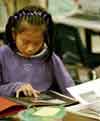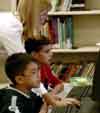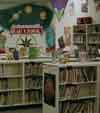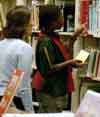Please feel free to e-mail this article to a friend, a principal, a parent, a colleague, a teacher librarian, a college professor, a poet, a magician, a vendor, an artist, a juggler, a student, a news reporter or anyone you think might enjoy it. Other transmissions and duplications not permitted. (See copyright statement below).
.
The Techno-Savvy, Book-Rich Media Center
by Jamie McKenzie
(about author)
© 2003, Jamie McKenzie, all rights reserved.
This article first appeared in the November/December 2003 issue of Library Media Connection.
|
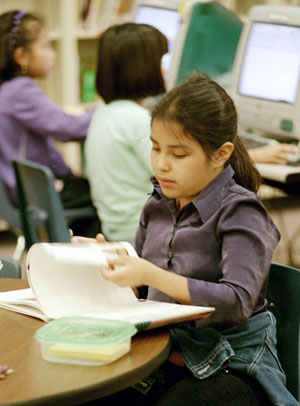
Grand Prairie ISD student exploring questions from her wonder box.
|
|
It is time to replace techno-lust with techno-savvy!
I. Back from the Brink of Digital Distress
Back before the Net came to schools, many of us had high hopes for digital library additions. We grabbed eagerly for articles about virtual libraries and some of us dreamed of abundance and digital riches unmatched by our print collections.
Some leaders were so anxious to network schools and fill classrooms with digital devices that we could fairly accuse them of techno-lust.
A decade later the after-taste is a bitter-sweet mixture of delight and disappointment. Digital abundance often turned to glut and the promised richness often proved more cloying than enlightening.
With the defrocking of dotcom forecasters and their sales pitches for digital schools and high bandwidth learning, surviving media specialists are finding themselves challenged to help their schools become more discerning consumers of new technologies.
As budgets constrict and No Child Left Behind (AKA Helter-Skelter) has shifted focus from technologies to scores, concerns about “real” student gains have come to the fore.
Surviving media specialists?
Sad to say, the past decade has done damage to library staffing in many states and provinces as districts have replaced certified elementary librarians with aides or assigned one person to cover several buildings.
In some places, misinformed administrators have defended this reduction in staff – a form of intellectual disarmament – by claiming that we don't need books or librarians because we now have the Internet. In some districts, librarians have been replaced with computer teachers or computers. In some schools the media center is padlocked much of the week.
In California, for example, state leaders generously funded equipment buys for “digital high schools” while allowing staffing levels for school libraries to erode disastrously across the state.
Misinformed? Educational, business and political leaders who think the Internet and its school computer hives can replace good libraries and librarians are mistaken. Many rich veins of our civilization’s knowledge base have never been digitized.
While the Net offers millions of documents, it often fails to provide critically important types of information and it tends to favor trendy, hot topics with a disneyfied flavor. In addition to neglecting or ignoring crucial categories of information, the Net suffers serious deficiencies with regard to quality, authority and accuracy. Some have compared this new “library” to a landfill. Lots of stuff. Not many treasures. Much digging required.
Given the severe limitations of the new information resources and the pressures on schools to produce capable thinkers, we need media centers to be techno-savvy and book rich.
II. Traits of Techno-Savvy
The words “techo” and “savvy” rarely appear together in conventional settings. The term techno-savvy goes undefined by dictionaries such as Encarta and American Heritage. The New York Times used techno-savvy in only three articles during the past year. A search at ERIC reveals the term techno-savvy employed in just one article.
Google the term "techno-savvy" on the other hand, and more than 10,000 Web pages appear. Techno-savvy is big on the Net. As far back as 1996, WIRED NEWS published an article, “Techno-Savvy Teens Won't Make Adults Obsolete ... Yet” - Nov. 21, 1996, http://www.wired.com/news/culture/0,1284,531,00.html.
And the term techno-savvy appears on 220 Web pages in conjunction with “librarian.”
The ALA has made the term techno-savvy a centerpiece of The Campaign for America's Libraries:
- Libraries are changing and dynamic places.
Librarians are techno-savvy, on the forefront of the information age. In a world that's information rich, they are information smart, and help ensure a society where everyone is information literate. You'll find the right answer @ your library™. http://cs.ala.org/@yourlibrary/keymessages.cfm
|
|
While I could find no definitions for techno-savvy in current dictionaries, the term as it applies to schools, librarians and media centers means more than being hip and comfortable with new tools and resources. The phrase is closely associated with discernment. Techno-savvy usually involves the following traits:
- Selective – Sometimes it seems as if the Net offers everything but the kitchen sink and is proud of its own glut. A strong media center speeds its clients to the most reliable, the most authoritative and the most accurate information. To accomplish this feat, the program invests in systems to identify quality and bring it to the attention of clients.
- Enriched – Many of the best digital resources cannot be found via search engines. The “Deep Internet” is a collection of digital riches that either require subscription fees or searching at specific sites that do not open their doors to search engines and their spiders. A strong media center program makes sure that the school is subscribed to the best online services while creating local “portals” to help staff and students to find the most valuable sites for specific kinds of information such as weather, crime statistics or news.
|
|
- Directive – While the early appeal of the Net was its support for independent searching, the charm of wandering rapidly wore thin. A few years later, many former surfers are disillusioned and disappointed, suffering from “search rage” – the failure to find good information after 10-12 minutes of trying. “Just show me the good stuff!” becomes the new cry. And media specialists - knowing the major research questions and pathways likely to emerge during any school year - act as guides, identifying the most promising sources so that students may spend 95 per cent of their time thinking about information rather than the same amount on mere wandering.
- Instructive – Technology and software companies are fond of wizards and artificial intelligence. “Let us do the thinking for you!” But media specialists know the dangers of surrendering such thinking to others. They understand that chief among their charges is the responsibility to foster independence. They teach students to make their own bread, create their own meanings and find their own truths. They shrug off the temptation to hand students a loaf of bread. They never seize a student mouse. They empower. They pass the baton. They demonstrate.
- Discerning – Just as all that glitters is not gold, not all that is digital or newly technological is worthy of a school’s investment or engagement. “Just say no!” is a perfectly valid response to some of the gimmickry and toolishness foisted upon schools by administrators and entrepreneurs besotted with techno-lust. Once the school has adopted clear goals and standards for program priorities, these standards can serve as filters to protect the school from foolish ventures. For more on this approach, see “Tech Smart: Making Discerning Technology Choices” in the May 2002 issue of From Now On at http://fno.org/may02/discerning.html
- Focused – Unlike a huge university or community library, a school media center may concentrate on doing a few things really well. It need not offer all things to all people. It cannot be comprehensive. But it can do some things exceedingly well. By identifying the priorities of the school in terms of curriculum and student research, the media center can collect and concentrate resources where they will do the most good. In an information landscape characterized by the poverty of abundance, the media center does well to offer quality.
- Client Oriented – The better the match between program, students, teachers and resources, the greater the prospects for efficient and enduring learning. Mere possession of networks and networked resources does not guarantee any such match. The effective media specialist seeks to identify and communicate matches so that end users get what they want. To a large extent this effect is accomplished through portals, channels and pathways through the digital jungle. If the media specialist fails to weave such connections in an active sense, then matches will be rare.
- Organic – The most effective programs will evolve much like a garden, with elements emerging, disappearing, flourishing and transformed as time passes and experience instructs. Passivity and stagnation in the face of an explosive new context will threaten the continuance of library programs, staffing and funding.
- Responsive – The characteristics of the user interfaces, pathways and portals should shift with time as clients try things out and share reactions to their experiences. The media specialist must invest heavily in questioning and surveying users to determine what has been happening and how services might be altered to improve the matches mentioned above.
- Alert – With the digital landscape shifting on a continuous basis, the program must be focused on changing opportunities, risks and trends, anticipating developments rather than allowing them to buffet the school. While it may be tempting to seek patterns and routines that endure, that search can be a trap. This is a time for a balanced lean forward.
- Strategic – In the face of a shifting landscape, the program must continuously reinvent itself, and those in charge must consider a wide array of tactics to achieve results. In years past we were comfortably able to lock down program definitions, goals and strategies for five or more years at a time. If we try that now, we might being Rip Van Winkled to death.
- Expansive – The new landscape is so vast that many folks are tempted to rest with what is offered over the so-called “free Internet.” Because many of the most reliable resources are available by subscription only or by proceeding directly to specific sites, the program must seek and publicize quality information resources aggressively. In some respects, the program works at cross purposes, shrinking down glut and garbage while expanding quality.
Networked – Connections and linkages with librarians, programs and thinkers outside the school serve to ease the burdens of prospecting, inventing and adapting as the human network exchanges insights and resources to reduce the load for all. At the same time, a vibrant human network within the school makes possible the kind of responsive, organic program mentioned earlier.
III. Book-Rich
| One could argue that it is impossible to provide a techno-savvy program that is simultaneously book-depleted. Huge holes in the array of digital resources currently available make possession of a strong print collection a necessity. Besides, contrary to the marketing of digital divas, printed books are a technology! |
|
This is not the place to build a full case outlining the shortcomings of digital resources. Such a case may be found in the article, “The Technology Presumption: Could Integrating Technology Sometimes be Wrong-Minded?” (McKenzie, May, 2003 issue of From Now On at http://www.fno.org/may03/wrongminded.html) In this article I demonstrate the difficulty of answering the following questions about Captain Cook (or other ship captains) without turning to print resources.
- Did he know how to use all the best instruments of his time?
- Did he keep a careful log?
- Did he usually know where they were?
- Did he ever get lost?
- Did he seem to know what he was doing?
- Did his ships have to wander around very much?
- Did he stay clear of known hazards?
- Did he know how to make the best of prevailing winds?
A techno-savvy program will offer a well balanced collection combining the best of digital offerings with the best of print possibilities. A techno-savvy librarian will know how to build such a collection and a techno-savvy student will know when to turn to each part of the collection.
A book-rich program will possess the following traits:
- Deep – The print collection will offer those kinds of evidence, data, stories and documents vital when researching essential questions embedded in the school’s curriculum. When it comes to the “human story” especially, books are more likely to provide the deep information required to make well-informed judgments. The Journals of Captain Cook, Penguin Classics by J. C. Beaglehole, et. al. are not available online. Many of the digital resources suffice for “trivial pursuit” but fail to cast light on more demanding questions about the human experience. The media specialist pays particular attention to the prime research questions of the school when acquiring print materials.
- Complementary – The print collection no longer needs to be all things to all people or offer comprehensive information on all topics. If some topics such as weather are well served by the data available at sites such as NOAA (http://www.cdc.noaa.gov) , then the media specialist can maintain print materials that augment rather than duplicate those digital resources. In times of scarce funding, we avoid information redundancy.
- Quirky – Given the support of digital collections, school print collections can now afford to specialize a bit by offering especially tantalizing nuggets and veins – collections that are appealing to the students in unusual ways. The students come to view the stacks as inviting. The media center becomes a curiosity shop. Tired of staring at screens, students find themselves intrigued and delighted by books that have been selected with their young minds, talents, fears, wonders and wishes in mind. A collection devoted to the essential questions, issues and dreams of life can provoke and inspire.
- Hip – Sad to say, the marketing apparatus of our society has whetted appetites for pop culture and style. Much as we might regret some of these trends, the media center program and collection must pay attention to issues of design, presentation and style in order to win audience share. We are now competing with ShockWave™ and MTV. But the word “hip” has some appealing meanings as described by Roget’s II: The New Thesaurus, Third Edition:
- hip
ADJECTIVE: Slang. Marked by comprehension, cognizance, and perception: alive, awake, aware, cognizant, sensible, sentient, wise1. Idioms: on to. See KNOWLEDGE.
- Cognizant - Now there is a powerful word. We are expected to dust off the shelves and make sure the print collection addresses the issues and concerns of the day in ways that will spark interest and awaken appetites. Are the books on our shelves a decade behind the times? Or do we offer a print collection that speaks with eloquence and passion of Iraq and Islam, of security, terror and civil liberties? Would Rip Van Winkle feel right at home or would he be dazzled by the contemporary qualities of our collection?
- Fictional – Narrative can be a strength of print collections. Despite all the hype about electronic books, the movement towards handheld e-books has pretty much failed to reach many readers according to reports by the New York Times and others. “MediaTalk; E-Books: An Idea Whose Time Hasn't Come” by David D. Kirkpatrick, New York Times, April 22, 2002. A book-rich collection and program places strong emphasis on current fiction, poetry and drama, playing to the passions and concerns of young readers, knowing how much they enjoy curling up with a good mystery, science fiction thriller or romance.
- Visual – Because computer and handheld device screens are usually quite limited and limiting, the print collection often provides much more vivid and compelling graphics than the newer technologies. While digital collections can sometimes offer a deeper and broader selection than a school library, there is something thrilling about holding a large format book in one’s hands.
- Coherent – It pays to contrast in good ways with the digital world. Whenever possible, the school media center offers coherence to students and faculty forced to cope with a chaotic and often frustrating information landscape. The program provides a shelter from information overload and glut. Resources are well organized and easy to find. There is little wandering and no search rage. Everything is pretty much where you would expect to find it.
- Convenient – In the book-rich media center, students can find what they need easily, efficiently and swiftly. The information is close at hand, the interface is friendly and staff members are eager to support the inquiry process.
- Current – Sadly, in some states the quality of media centers is measured by the number of volumes on shelves. In the book-rich library, quality is measured by different values – currency, scholarship and cogency. Outdated, racist volumes are weeded earlier rather than later. Depth is determined by the value of fewer volumes and pages. The media center should be a refuge from glut and garbage. This is another case when less can be more.
IV. Implications
Management of such a techno-savvy, book-rich media center is extraordinarily demanding. This is not a packaged program that you can pull down off a shelf. The success of the program depends upon extensive and frequent communication with stakeholders to ascertain how program elements may best be shaped to provide a strong match with their interests and wishes.
Library programs must re-invent themselves almost daily in order to ride the white water that started flowing through schools with the introduction of new information technologies a decade back. Confronted by leaders who see no need for library services, programs must answer such threats by demonstrating value in ways unheard of a decade ago.
The Internet has a soft underside – its vulnerabilities, weaknesses and disappointments. Savvy librarians will exploit those vulnerabilities, offering efficiency, depth, value and coherence to clients who have tired of endless surfing. Especially savvy librarians will serve great coffee and offer comfortable, inviting seating areas along with information that is both convenient and illuminating.
|
|
 From Now On
From Now On


